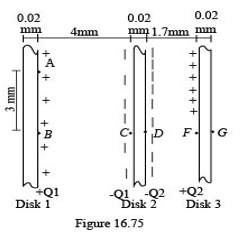2 Three charged metal disks are arranged as shown in Figure 16.75 (cutaway view). The disks are held apart by insulating supports not shown in the diagram. Each disk has an area of 2.5 m2 (this is the area of one flat surface of the disk). The charge and the charge .

(a) What is the electric field (magnitude and direction) in the region between disks 1 and 2? (b) Which of the following statements are true? Choose all that apply. (1) Along a path from A to B, (2) (3) localid="1657088862802" . (c) To calculate , where should the path start and where should it end? (d) Shouldlocalid="1657089209063" be positive or negative? Why? (1) Positive, because localid="1657089087291" is opposite to the direction of . (2) Negative, because is in the same direction as . (3) Zero, because. (e) What is the potential difference ? (f) What is the potential difference ? (g) What is the potential difference ? (h) What is the potential difference ? (i) What is the potential difference? (j) The charged disks have tiny holes that allow a particle to pass through them. An electron that is traveling at a fast speed approaches the plates from the left side. It travels along a path from A to G. Since no external work is done on system of plates + electron, . Consider the following states: initial, electron at location A; final, electron at location G. (1) What is the change in potential energy of the system? (2) What is the change in kinetic energy of the electron?





